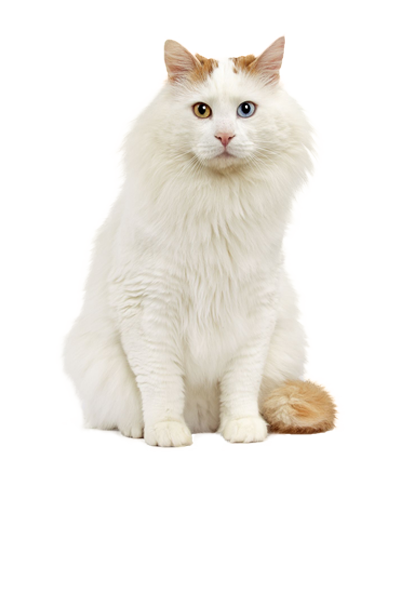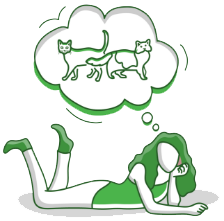
Turkish Van Breed Pictures
Vital Breed Stats
| Weight: | 5 - 8 kg M | 5 - 8 kg F |
| Life Expectancy: | 15 - 18 years |
Breed Characteristics
| Size: |  |
| Grooming: |  |
| Good with Children: |  |
| Good with other pets: |  |
| Affectionate: |  |
| Active Level: |  |
Give a thumbs up if you love the Turkish Van

0
More About the Breed
History
It is believed that the first recorded Van cat dates back to 1600-1200 BC. It is said to have semi-longhaired coats with ringed tails and coloured heads. Different forms of art have proved its presence in the ancient times, including carvings in pieces of jewellery, battle standard, and figurines.
Different forms of art have proved its presence in the ancient times. The Van cat’s origin in modern history has been well documented as well. The breed originated in the Lake Van of Turkey. In 1954, Journalist Laura Lushington and photographer Sonia Halliday were given two Turkish Van kittens (a male and a female) which they successfully imported to Britain. The female soon produced a litter of kittens having the ‘van patterning’ which refers to its distinctive ‘top-and-tail’ markings.
For years, other breeders supported Lushington in her quest for breed recognition in the UK. In 1959, Lushington and Halliday returned to Turkey to obtain two more kittens. From then on, they established a careful documentation of its breeding programme. In 1969, it reached its full GCCF Championship in Britain. It wasn’t until 1982 when the breed was introduced in the USA and in 1994, it gained a Championship status with the Cat Fanciers Association (CFA).
Appearance and Grooming
Male Turkish Van cats can weigh from 10-20 pounds whilst the females weigh 7-12 pounds. It has a sturdy body with a broad chest. It gains full maturity after three years or more. Everything is well-proportioned boasting a robust appearance with well-rounded paws that are tufted. It has a coloured plumed tail.
Another striking feature of a Turkish Van cat is its eye. It has large oval-shaped eyes with pink rims that made it look attentive and expressive. This feline is born with pale blue eyes that change to deeper blue or amber as the cat grows older. Some Turkish Van cats have odd-coloured eyes.
The Turkish Van’s head is broadly wedged shaped with ears that are moderately large. The insides of the ears are well feathered. The breed’s admirable long coat is soft and silky from the roots without woolly undercoat. The ruff on its neck and chest becomes fluffier as the cat matures. This breed is a pure white feline with colour markings on its head and tail. At present, more colours and pattern emerge including black, blue, tortie, and tabby.
The cashmere-like texture of the cat’s fur may seem like it is high maintenance, but once a week brushing would suffice. The Van cat requires basic grooming such as regular nail trimming, teeth brushing, and ear cleaning. The earlier these grooming routine is introduced, the better.
Temperament and Intelligence
With its water-resistant coat, the Turkish Van cat enjoys the rain and water. If it is not following its owner around, it may be busy exploring taps in the bathroom or playing on a sink in the kitchen. This fur ball is full of energy and loves to jump, climb and play retrieving and chasing games. It is also known for its love of heights. As a result, it can often be found perched up in high areas of the room. However, this playful feline is a bit clumsy that would frequently bump into things and unintentionally knock them over.
This feline might not be right if you are looking for a lap cat. It may be affectionate but it does not like to be picked up or cuddled a lot. It is an independent cat that loves to have its own space. Its interaction with people or with other animals should be on its own terms. It will attach itself to its chosen human who tends to its care. It can also be quite vocal producing a unique sound that resembles the sound of a sheep.
Nutrition and Feeding
The Turkish Van cat should be provided with a proper diet that fulfils its nutritional needs. It should be consistently given the same food following the same feeding schedule. If there are changes to its diet, those must be done gradually to prevent digestive problems.
The serving portions should depend on the cat’s weight, age, and activity level. Its diet must include at least 25% protein and just 5% carbohydrates.
Health and Exercise
On average, the Turkish Van cat lifespan ranges from 12 to 14 years. This cat breed is among the healthiest and is not known to be affected by hereditary health issues.
However, there have been cases of obesity among Turkish Van cats. As such, it is necessary to be firm in monitoring its diet. Further, ensure that this feline gets enough exercise and its diet managed well to prevent it from becoming overweight. Being an intelligent breed, it should be provided with toys and activities that will also challenge its mental abilities.
Cost of Ownership
Turkish Van cat breeders are uncommon in the UK. As such, acquiring one takes considerable time. Generally, a Turkish Van kitten costs between £300 and £460. The monthly costs of caring along with its food costs and other pet care needs largely depend on the area and the special needs of the said feline.
Turkish Van Breed Highlights
- It is an independent feline that enjoys its own space.
- It is a fur ball of energy that loves playing with water, jumping at great heights and running around the house.
- It requires minimal grooming.









